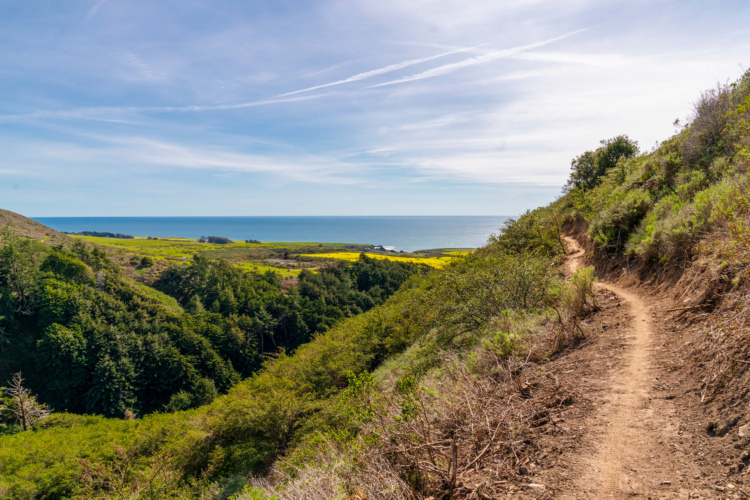One of my favorite phrases in Italian was uttered by a national hero of superbike racing, named Fabrizio Pirovano. Eurosport interviewed him following an event and he shared this philosophy for piloting the rocket road machine: “Se sei incerto, tieni aperto.” It English that closely translates to “If you’re uncertain, keep it open.” By “it” he meant the throttle, and he experienced massive success with this simple philosophy throughout his superbike career with Yamaha, Ducati, and Suzuki between 1988 and 2001.
I and a lot of the far faster professional riders I have interviewed apply this philosophy to mountain biking, though their idea of open is decidedly gutsier than mine. I also find it helpful as a maxim for some life choices.
How far you can keep the proverbial throttle cracked depends largely on how much you trust your brakes to scrub speed when things get too spicy. In fact, within gravity mountain biking, easing off the brakes is more or less our throttle. When we ask professional gravity racers what single component makes their bike more capable than any other, the most common answer is “a powerful set of disc brakes.”
The importance of proper stoppers is even more apparent for riders who raced downhill in the era of rim-brakes. Not only were rim brakes less powerful to begin with, but their power faded dramatically the more you used them, and there was always the threat of the associated heat causing the tube to pop or the rim or tire to fail. Though they included a new list of engineering challenges, disc brakes largely solved those initial slowing woes.

I recently reviewed a YT Jeffsy Base mountain bike, and while the geo and much of the build kit was dialed, the bike was specced with under-powered SRAM Guide T brakes brakes front and rear. Given the frame’s capability and high speed descending intentions, the four-piston brakes felt under powered to the point that they’re dangerous for anyone looking to push the limits of traction and balance on the Jeffsy. I received some comments of concern and confusion around my assessment of the bike’s brake spec. One message read, “Surprised about the brakes. Aren’t they 4-piston? I haven’t heard anyone else concerned about them.” Given these concerns, I wanted to share a little about how I evaluate brakes, and why they are one of the most important components on a bike.
Put simply, well designed and properly set up/bled four-piston gravity brakes offer consistent power at the lever that ramps up at a predictable rate, doesn’t require undue hand fatigue to actuate, and they have a fully locked skid point that doesn’t involve flexing the lever to the handlebar. The brakes on the Jeffsy Base model didn’t include any of those important qualities. With a fresh bleed and new pads they needed far too much hand muscle to actuate, causing notable fatigue on steep terrain, and the only way to get any real power out of them was to wrench the lever all the way to the bar and hope for the best. That’s not what I’m looking for in an emergency braking situation, nor when scrubbing speed on a steep trail I haven’t seen before.
The SRAM Code RSC brakes famously offer a wide range of predictable power, with fantastic modulation and a hard bite point that riders can trust to save the day and shave milliseconds. That is the sort of power I want when it’s time to shut the throttle down. The Hayes Dominion and Formula Cura4 brake sets both have a vast power modulation at the lever that feels similar to the Code RSC.
Shimano’s Saint and XTR 4-pistons have a shorter modulation range, with comparatively massive speed scrubbing capabilities. Their lever requires even less finger input to reach the maximum power point than those mentioned above, and some riders prefer that immediate response over the broader modulation spectrum. The only brake I’ve tested that genuinely combines all of these elements, and adds to the power quotient is the Direttissima from Trickstuff. With almost unnoticeable lever pressure the Direttissima 4-piston brakes have the power to stop any bike and rider that can be stopped, provided that lever is pulled in time.
Having tested all of these top-power brakes personally, I wouldn’t say that one is necessarily better than the other. They function in different ways to provide predictable slowing forces that give riders the confidence to use them less, and it’s up to the individual to decide which one best suits their needs. For anyone who often rides gravity trail as fast as they can, brakes are one component that’s worth spending a little extra cash on. Fortunately, we have loads of in-depth reviews to help that decision along.

So, once folks purchase a max-power set of stoppers how do those components help them ride faster? For starters, when riding new or lesser-known trails fast we will encounter unexpected obstacles and features that require split second decisions. If I see a helmet-sized stone in the middle of a turn I will need to immediately decide if I can hop over it or hit the brakes to redirect and get around it. Once that decision is made I need to trust that my brakes have the power and predictable functionality to work exactly as they always have, without additional thought or decision making.
The above is a fairly mild “emergency braking” scenario, and the stakes only escalate from there. Imagine that mid-turn rock is a six foot deep drop and you don’t know what the landing looks like. While you can usually slow down and take a peek, there will be times when powerful brakes make the difference between that pause-and-peek or a nasty dirt-nap.
On fall lines and otherwise wall-shaped, steep tracks, braking power coupled with good traction from your tires and suspension are the main factors allowing you to steer and scrub what little speed you can to stay in control. Provided your cockpit and brakes are properly set up, and you have the requisite fitness, a top notch pair of brakes will allow you to ride a 10-20 minute steep and rowdy descent without unnecessary hand or forearm pain. Without that pain, you won’t be worried about your grip strength diminishing, and you will be able to ride faster with more confidence as a result. The YT Jeffsy Base, mentioned above, is fully capable of steep and rowdy riding, but its stock brakes are not.
Endo-turns or nose presses are another crucial moment where powerful brakes will shine brightly. When a switchback is too sharp to simply ride, the options are to get off and turn the bike, or pivot the frame on the front wheel. With predictable brakes and a little practice this maneuver can be relatively simple and efficient. Some pro riders who truly trust the power of their calipers can even nose-press without slowing down much. They feather the front brake power all the way through the turn without stopping the front tire’s forward motion. While we don’t all need to master the single-wheel switchback, good brakes do make it a lot easier to try.
One of the most crucial use cases for motorcycle-stopping brake power is in “on-sight” enduro racing, when athletes are trying to achieve the fastest run possible on a track they have not yet ridden. The winners keep the throttle cracked wide open, and trust that their brakes, traction, and skills will save them from the uncertain. The brakes are a load-bearing leg on that stool of confidence, and without them, the skills and traction suffer. Put as plainly as possible, winners can ride faster because they have powerful brakes.
FInally, if you ride with a trail dog, you know you need good brakes. An errant squirrel could catch their eye at any moment, and in front of the bike they will dart. Even the most well trained canine can be thrown off their game by a fun snack.

Do you have a story of your disc brakes saving the day or shaving time off the clock? Please share it with our community below. In the mean time, “Se sei incerto, tieni aperto.”











0 Comments